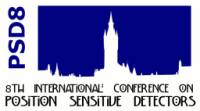Speaker
Dr
Tatsuya Nakamura
Description
An effective pixel size of a two-dimensional wavelength shifting fibre (WLSF) neutron image detector was improved from 0.5 mm down to 0.17 mm with implementing a fibre optic taper (FOT). The main part of the prototype detector consisted with a thin ZnS/6LiF screen, the FOT, and the crossed WLSF ribbons for x and y coordinate. The WLSF image detector had 16 x 16 fibre channels and the light signals in each fibre were read out individually. The FOT that was made out of fine glass fibres with a taper ratio of 3.1 was implemented in between a scintillator screen and the WLS fibres, which worked as an image magnifier. The original detector that equipped with a scintillator screen without a FOT exhibited a spatial resolution of around 0.8 mm. The spatial resolution of this detector was dominated with a light disperse in the screen and the side length of a fibre of 0.5 mm. The prototype detector equipped with the FOT measured a narrow neutron beam with a finer pixel size whilst the same WLSF were used for readout. This result indicated a possibility to improve the effective pixel size / spatial resolution with a FOT device. This kind of detector would be quite unique and useful for energy-selective neuron radiography at a pulsed neutron source because of its neutron counting capability.

